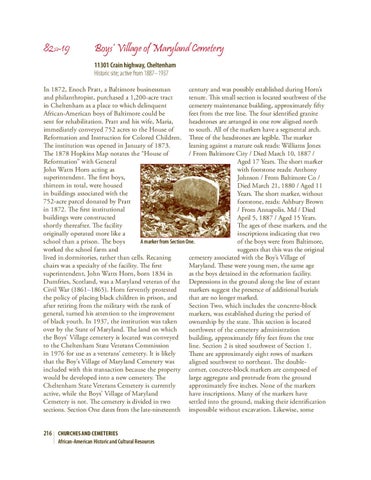82A-19
Boys’ Village of Maryland Cemetery 11301 Crain highway, Cheltenham Historic site; active from 1887–1937
In 1872, Enoch Pratt, a Baltimore businessman century and was possibly established during Horn’s and philanthropist, purchased a 1,200-acre tract tenure. This small section is located southwest of the in Cheltenham as a place to which delinquent cemetery maintenance building, approximately fifty African-American boys of Baltimore could be feet from the tree line. The four identified granite sent for rehabilitation. Pratt and his wife, Maria, headstones are arranged in one row aligned north immediately conveyed 752 acres to the House of to south. All of the markers have a segmental arch. Reformation and Instruction for Colored Children. Three of the headstones are legible. The marker The institution was opened in January of 1873. leaning against a mature oak reads: Williams Jones The 1878 Hopkins Map notates the “House of / From Baltimore City / Died March 10, 1887 / Reformation” with General Aged 17 Years. The short marker John Watts Horn acting as with footstone reads: Anthony superintendent. The first boys, Johnson / From Baltimore Co / thirteen in total, were housed Died March 21, 1880 / Aged 11 in buildings associated with the Years. The short marker, without 752-acre parcel donated by Pratt footstone, reads: Ashbury Brown in 1872. The first institutional / From Annapolis. Md / Died buildings were constructed April 5, 1887 / Aged 15 Years. shortly thereafter. The facility The ages of these markers, and the originally operated more like a inscriptions indicating that two A marker from Section One. school than a prison. The boys of the boys were from Baltimore, worked the school farm and suggests that this was the original lived in dormitories, rather than cells. Recaning cemetery associated with the Boy’s Village of chairs was a specialty of the facility. The first Maryland. These were young men, the same age superintendent, John Watts Horn, born 1834 in as the boys detained in the reformation facility. Dumfries, Scotland, was a Maryland veteran of the Depressions in the ground along the line of extant Civil War (1861–1865). Horn fervently protested markers suggest the presence of additional burials the policy of placing black children in prison, and that are no longer marked. after retiring from the military with the rank of Section Two, which includes the concrete-block general, turned his attention to the improvement markers, was established during the period of of black youth. In 1937, the institution was taken ownership by the state. This section is located over by the State of Maryland. The land on which northwest of the cemetery administration the Boys’ Village cemetery is located was conveyed building, approximately fifty feet from the tree to the Cheltenham State Veterans Commission line. Section 2 is sited southwest of Section 1. in 1976 for use as a veterans’ cemetery. It is likely There are approximately eight rows of markers that the Boy’s Village of Maryland Cemetery was aligned southwest to northeast. The doubleincluded with this transaction because the property corner, concrete-block markers are composed of would be developed into a new cemetery. The large aggregate and protrude from the ground Cheltenham State Veterans Cemetery is currently approximately five inches. None of the markers active, while the Boys’ Village of Maryland have inscriptions. Many of the markers have Cemetery is not. The cemetery is divided in two settled into the ground, making their identification sections. Section One dates from the late-nineteenth impossible without excavation. Likewise, some
216 CHURCHES AND CEMETERIES African-American Historic and Cultural Resources
